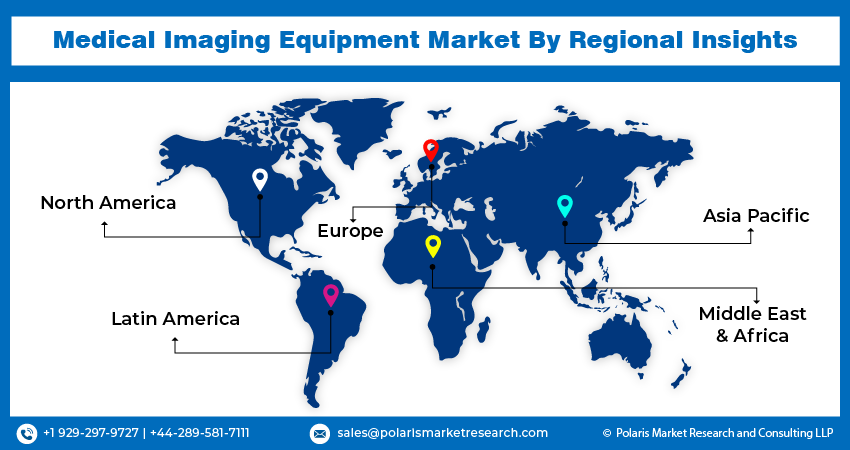Market Overview
The medical imaging equipment market, a cornerstone of modern diagnostics, was valued at USD 46,639.36 million in 2023. Projections indicate growth to USD 48,551.58 million in 2024, reaching USD 74,216.80 million by 2032. This trajectory reflects a compound annual growth rate (CAGR) of 5.3% during the forecast period. This growth is driven by advancements in imaging technologies, increasing healthcare expenditures, and the rising prevalence of chronic diseases necessitating advanced diagnostic tools.
Some of the major players operating in the global market include:
- Canon Inc.
- Carestream Health Inc.
- Esaote S.P.A.
- Fujifilm Corporation
- General Electric
- Hologic, Inc.
- Koninklijke Philips N.V.,
- Narang Medical Limited
- PLANMECA OY
- Siemens Healthcare Private Limited
Market Drivers
- Technological Advancements: Continuous innovation in imaging technologies, such as AI integration, 3D imaging, and compact systems, is enhancing diagnostic accuracy and patient outcomes.
- Rising Prevalence of Chronic Diseases: The growing burden of chronic diseases, including cancer, cardiovascular diseases, and musculoskeletal disorders, is fueling demand for advanced diagnostic imaging.
- Aging Population: The global aging population requires frequent diagnostic evaluations, contributing significantly to market growth.
- Healthcare Infrastructure Development: Emerging economies are investing heavily in healthcare infrastructure, leading to increased adoption of state-of-the-art imaging equipment.
Market Trends
- Integration of Artificial Intelligence (AI): AI-powered tools, such as those introduced by Planmeca in March 2023, are revolutionizing diagnostic imaging by improving accuracy, automating workflows, and enabling real-time analysis.
- Compact and Mobile Systems: Compact systems, such as Fujifilm’s 128-slice CT system introduced in November 2023, are gaining popularity for their portability and efficiency in various healthcare settings.
- Focus on Patient Comfort: The development of patient-friendly systems like Esaote’s S-scan Open, launched in October 2023, underscores the emphasis on enhancing patient and operator experiences.
- Collaborative Efforts in Innovation: Partnerships, such as the collaboration between Carestream Health and EXAMION in October 2023, are driving forward-thinking healthcare imaging solutions.
Challenges
- High Costs: The significant investment required for advanced imaging systems can deter smaller healthcare facilities from adoption.
- Regulatory Hurdles: Compliance with stringent regulatory standards and approval processes can slow down market entry for new products.
- Shortage of Skilled Professionals: The lack of adequately trained radiologists and technicians in some regions poses a challenge to effective utilization of imaging equipment.
Opportunities
- Emerging Markets: Rapid economic growth and increasing healthcare investments in Asia-Pacific, Latin America, and the Middle East present significant opportunities.
- Telemedicine and Remote Diagnostics: The integration of imaging systems with telemedicine platforms is enabling remote diagnostics, especially in underserved areas.
- AI and Big Data Analytics: Leveraging big data and AI for predictive diagnostics and personalized medicine offers immense potential for market players.
Segment Analysis
The medical imaging equipment market is categorized by product type, application, and region:
By Product Type:
- X-Ray Systems
- Ultrasound Systems
- MRI Systems
- CT Scanners
- Nuclear Imaging Equipment
By Application:
- Oncology
- Cardiology
- Neurology
- Orthopedics
- Others
By Region:
- North America
- Europe
- Asia-Pacific
- Latin America
- Middle East & Africa
Recent Developments:
- Fujifilm’s Compact CT System: In November 2023, Fujifilm unveiled a compact 128-slice CT system with vision modeling iterative reconstruction, significantly reducing radiation doses and offering scalable solutions for diverse healthcare settings. This was showcased at the RSNA annual meeting.
- Esaote’s S-scan Open MRI System: Introduced in October 2023, this MRI system emphasizes musculoskeletal exams with advanced performance and optimized imaging algorithms, enhancing both operator and patient experiences.
- Planmeca’s AI-based Tools: In March 2023, Planmeca launched AI-powered tools integrated into its Romexis platform, revolutionizing dental imaging, diagnosis, and treatment planning across various specialties.
- Carestream and EXAMION Partnership: The collaboration announced in October 2023 focuses on improving radiography workflows and clinical outcomes, reinforcing Carestream’s commitment to innovative imaging solutions.
Future Outlook
The medical imaging equipment market is set to expand significantly, driven by technological innovations, growing healthcare needs, and strategic collaborations among market players. The integration of AI, development of patient-centric solutions, and expansion into emerging markets will further shape the industry’s future.
In conclusion, the medical imaging equipment market is on a robust growth trajectory. Innovations like AI-based tools, compact and mobile systems, and enhanced imaging algorithms are revolutionizing diagnostics and patient care. With a focus on improving clinical outcomes and operator efficiency, the industry is poised to witness significant advancements in the years to come.
More Trending Latest Reports By Polaris Market Research:

